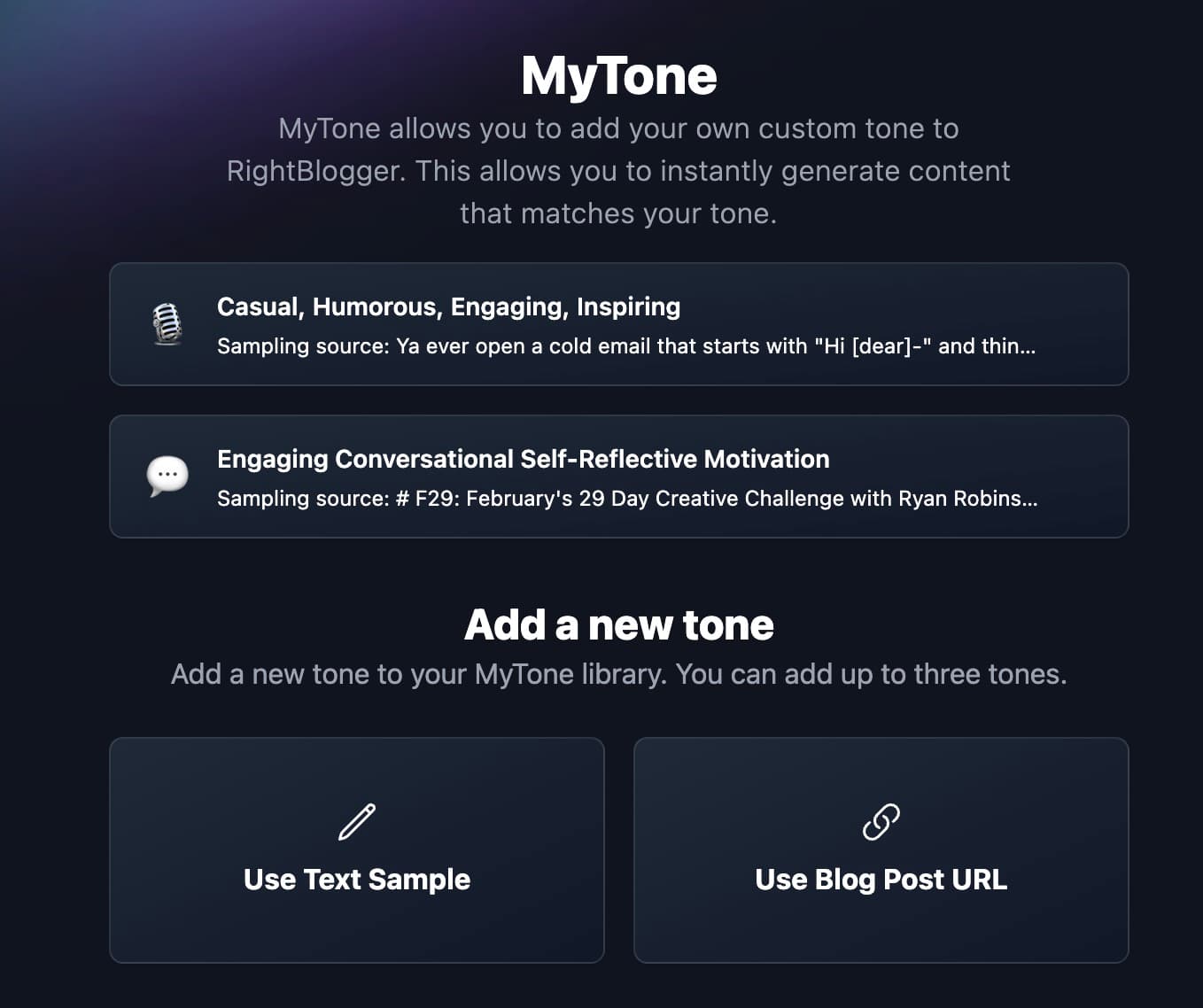AI for Writers: Boost Productivity & Quality (2025)

Jumping into the world of AI for writers, can feel like tip-toeing your way through a tricky maze. Sure, everyone talks about how efficient it is, and you might’ve even given some of these tools (like RightBlogger) a spin, yourself.
But let’s be real—the nagging questions about whether AI is ethical, or if these tools live up to all the hype, can leave you in a state of paralysis analysis. As a writer & content marketer who stumbled into using AI early on, I get it. Sometimes I weave AI into my writing, but other times, I hold back because some clients have strong opinions about it—or the use case at hand just doesn’t feel quite right.
So, in this guide, let’s chat about using generative AI as a writer—covering the ethical stuff, giving you the lowdown on how to use it (the right way), and sharing some top-notch generative AI tools for writers. Let’s dive in.
Ethical Concerns of AI for Writers
Alright, let’s tackle the big question upfront: Is it ethical to use AI as a writer?
Well, it’s not a straightforward yes or no. It depends on your specific situation.

If you’re a freelance writer, and your client isn’t on board with AI handling some of your tasks, then it’s a no-go. Stick to using AI for very top-line tasks like proofreading or generating meta descriptions.
But if your client is cool with your experiments into AI-assisted writing, then why not make the most of it? There’s nothing wrong with embracing AI across various stages of content creation, and plenty of folks are doing just that.
According to joint research by Databox and Penguin Research, companies rely on generative AI to write 78% of their blog posts.
Don’t let the noise on social media throw you off. At the end of the day, as long as you meet your client’s expectations and avoid plagiarism, the specific writing method you use is irrelevant.
AI’s Impact on Creativity
Think of creativity like using an ATM: you can only withdraw what you’ve deposited. Generative AI has the potential to either enhance, diminish, or leave creativity untouched—it all depends on the individual writer.
As a content writer, if you rely on AI to do the creative aspect of your work, it means you have never been creative. If you use it to smash through writer’s block and expand on your creative idea, you’ll see a boost in your creativity and efficiency.
What you give to AI is what you get.
Ownership of Content Generated by AI
No doubt, there are ongoing issues about the ownership of content generated with AI, but this is a complex and evolving topic.
As a writer today, the content you create is your intellectual property. Using AI to brainstorm ideas or even compose entire articles is perfectly legitimate—as long as you’re not plagiarizing or copying others’ ideas.
And if anyone is likely to get in trouble for copyright infringement, it’s not you. A good example is the case of the New York Times vs. Open AI.
Here are a few things to keep top of mind:
- When AI gives you external data, double-check to verify if you are allowed to use it. And if you are, be sure to give credit to the owner. Otherwise, you’d be stealing.
- Pay attention to regulative discussions as discussions around creating AI policies are beginning to take shape. Organizations and government entities are actively discussing rules around privacy, liability, copyright, and intellectual property for generative AI tools and the content they create.
- Weave your own creativity, story, voice, tone into the final work. Features like MyTone inside RightBlogger are designed to do just that. The more human creative input that is added to AI-generated content, the safer it is to publish.

What are the Upsides of AI for Writers?
Now that we’ve addressed some of the biggest concerns and potential drawbacks of AI, let’s take a quick look at the upside of AI for writers.
Overcoming Writer’s Block
Facing a blank screen is a common struggle for writers. Some days, breaking through that dreaded writer’s block feels impossible, hampering your productivity.
That’s where tools like blog post idea generator come into play:

With generative AI, writer’s block is no longer a problem. Even if you don’t end up using the entire first draft of an article you create using AI (I usually don’t), simply letting it kickstart the writing process can be the spark you need to get going.
Inspiration works like a faucet—once you turn it on, it flows freely for a while. So instead of waiting endlessly or raiding your fridge for cookies when writer’s block hits, turn to AI for a boost.
Improved Productivity
Generative AI offers numerous productivity boosts—it generates ideas, assists in outlining, provides initial drafts, aids in research, offers editing capabilities, and much more. Of course here at RightBlogger we have a ton of tools for all these use cases.
Furthermore, it can analyze your article to highlight areas for improvement—a task that would typically consume valuable minutes of your time.
By automating these tasks, you free up valuable time to concentrate on more challenging and rewarding endeavors.
AI for Content Writers: 9 Ways AI Can Help
Here are some of my favorite ways AI can help you as a writer.
1. Ideation & Research
Research and nailing the right idea, forms the foundation of high-quality content, spanning from expert interviews, to competitive analysis, and even spotting strategic content gaps you can exploit.
When it comes to streamlining content creation, AI can be a game-changer, particularly during the research phase. Personally, I use AI in these key ways to enhance my AI writing process. This is how I do it.
2. Interview Questions
Ideally, you’ll spend a huge portion of your time crafting the questions you want to ask your subject matter experts. Generative AI has proven invaluable in aiding this process by assisting in formulating the foundational questions for interviews.
For instance, when tasked with writing an article on the future of virtual reality (VR)—a topic outside my expertise—I turned to Perplexity.ai. I requested a list of relevant questions to pose to an SME, and it provided valuable guidance, offering a starting point for my research.

Armed with these questions, I have a clear roadmap for my interview, saving me significant time and ensuring that my questions are top-notch—a task that could have taken me ages to accomplish on my own, with no guarantee of the same level of quality.
3. Audience Research
AI is a vast repository of data, and asking AI questions about the audience of an article can help your research.
For this, I used ChatGPT.
In the screenshot below, I entered the title of an article and asked ChatGPT to identify the audience of the article. See the answer below:

I went further by inquiring about the problems these individuals are trying to solve. In response, ChatGPT provided the following insights:

Now, that gives my article a clear direction.
Of course you can use the prompts I’ve shown in RightBlogger chat as well.
4. Outline Generation
Writers often navigate through various topics and industries, each presenting unique challenges in terms of creativity requirements and structural considerations.
As a writer myself, I understand the daily struggle of determining the optimal format for an article, selecting relevant sections, and optimizing it for SEO.
AI can be a valuable tool in this process, helping you craft well-organized outlines that cater to both SEO needs and reader engagement. Furthermore, it can stimulate creativity by proposing alternative structures and approaches, encouraging the exploration of new ideas and formats to enhance content impact.
With AI’s capability to swiftly analyze content and identify successful structural patterns and key points from existing articles, it’ll boost your efficiency.
Whether you choose to follow the AI-generated outline or not, its analysis can provide valuable insights for crafting outlines, which can serve as a solid foundation for your article structure.
Here’s a blog post outline generated by RightBlogger, which I find impressive. I can customize it as needed before proceeding to draft my article.

5. Transcription
AI can help you by converting spoken words into written text, which is important for improving productivity and capturing ideas on the go.
By helping you to transcribe interviews, meetings, or lectures, you can quickly and accurately capture their ideas without the need for manual typing which takes too much of your time and mental bandwidth.
The benefits of this are innumerable. whether you’re talking to an SME, transcribing YouTube Videos or Podcasts, or transcribing a meeting, you can minimize errors and spare yourself a lot of time.
For this, I use:
- Otter.ai: for notetaking
- RightBlogger’s YouTube to Blog Post: for YouTube video transcription
6. Summarization
AI also offers the ability to condense lengthy content into concise summaries and extract key information from research materials. If you’ve ever found yourself sifting through endless materials to grasp a topic, you’ll understand the importance of such a feature.
This can be useful in many ways, whether that’s extracting insights out of an article, writing your article conclusion, formulating an opinion about a piece, and so on.
Let me show you an example with RightBlogger’s Summarizer.

7. Proofreading
Even though you’ve probably used AI for this task for a while now, it bears mentioning again—because AI proofreading and checking tools are getting significantly better today.
AI excels in locating typos, misspellings, grammatical mistakes, inconsistencies, and stylistic flaws. Some popular AI-based proofreading platforms include:
- RightBlogger’s Grammar & Spelling Fixer
- Grammarly
- Quillbot
These tools can scan and analyze documents at lightning speed, saving hours of tedious manual labor.
They also boast impressive precision rates, ensuring that even minor errors don’t slip past undetected.
And if—like me—you can’t afford expensive human editors and cut down expenses, AI can help you polish your work up.
8. Finding Examples
This particular use case is very personal for me because I love giving examples in my articles.
Examples make your content more resonant, powerful, and practical. But the most relevant ones don’t always come easily, and this is where AI comes in handy.
In the heat of writing when you need to cite an example, you can go to ChatGPT and ask it to provide examples for your context.
Let’s say you’re writing an article about the role of AI in customer service, and you’re looking for an example to highlight how AI-powered chatbots are being used to enhance customer interactions. You could ask ChatGPT:
“Can you provide an example of how AI chatbots are being used in customer service to improve user experience?”
9. Cold Email Generation
To use any of the above features, you’ll need clients, and cold emailing is one of the ways to get clients.
An AI-powered cold email generator can benefit you by providing personalized, efficient, and scalable solutions for crafting engaging cold emails.
I know personalization is one of the things that keep writers away from automating cold emails, but worry not.
Generative AI has really come far, and if you can find the right tool and feed it the right information, you’ll get a personalized email in a fraction of the normal time.
Do I have any particular tool in mind? Yes, RightBlogger does an awesome job at this. See an example below:

After a few tweaks to this cold email, it’ll be ready to go.
3 Best Generative AI Tools for Writers
We’ve got you covered on how to use AI as a content writer, so now here are my picks for the best AI tools for writers to utilize today:
1. RightBlogger

RightBlogger is a generative AI platform built for bloggers and content writers. It has over 80 blogging tools and is very easy to use.
While RightBlogger has several tools, the tools I enjoy the most as a writer are as follows:
AI Article Writer
Tired of staring at a blank page? RightBlogger’s AI Article Writer is your secret weapon for overcoming writer’s block and accelerating your content creation. It’s not about replacing your creativity; it’s about giving you a powerful head start.
Here’s how it helps:
- Generate Complete First Drafts: Provide a topic or keywords, and the AI Article Writer crafts a full-length draft, complete with an introduction, body paragraphs, and a conclusion.
- SEO-Optimized Content: The tool helps you create content that’s optimized for search engines, increasing your chances of ranking higher in search results.
- Customize and Refine: The generated draft is a starting point. Easily edit, add your own insights, and refine the content to match your unique voice and style.
Content Gap Analysis
This tool has been a game-changer for me, saving countless hours of research time. As part of my writing process, I typically conduct SERPs analysis to identify opportunities to provide more value than competing articles on Google.
However, this process can be incredibly time-consuming and draining. With RightBlogger, I no longer need to meticulously analyze every detail of multiple articles. Instead, I simply instruct the tool to analyze the top two articles, compare them, and provide insights on how I can improve my content.
Post Outline Generator
RightBlogger swiftly generates post outlines, often in a matter of seconds. You can either specify what you’d like included in the outline or customize the one provided by the platform.
This feature has proven to be immensely helpful in streamlining my writing process. Content agencies will also benefit immensely from this because this is one of the best ways content agencies can use AI.
Summarizer
This feature eliminates the need to painstakingly read through lengthy posts or materials. Simply paste the content into RightBlogger, and it will generate a concise summary for you.
Pricing: RightBlogger costs $29.99/month for unlimited usage
You can sign up for RightBlogger here, and try out almost all the tools for free.
2. Perpelexity.ai

Perplexity AI is a search engine that works like a chatbot. You ask it a question and it pulls answers from all across the web, summarizes them for you, and provides links to some of the articles it got the answer from.
It’s a good writing assistant that can help you streamline your research process.
3. Anyword

Anyword is a generative AI that focuses on ad generation. Although it also writes blog posts, it’s built for ads and has complementary features, such as predictive performance analytics, preset keyword library, and integration with social media platforms.
All these make it an excellent tool if you want to promote any of your content on social media.
How Useful is Generative AI for Writers?
As in all things, there are clearly some effective and (many) ineffective ways to use AI in writing. Merely relying on it to generate text without human oversight falls into the latter camp. When you read purely AI-written content, you know it.
However, when employed for specific tasks like research, ideation, strategizing, repurposing, and editing, AI can significantly enhance your writing output and efficiency. It’s super important to maintain human oversight with any generative AI writing though—the quality and integrity of the work you publish hangs in the balance.
Wanna take your AI writing to the next level?
Sign up for RightBlogger here, and try almost all of our tools, completely free.
Is it ethical to use AI for writing blog posts and client work?
Yes, it can be ethical, but it depends on your rules and your client’s expectations.
If you are a freelancer, ask the client first. If they do not want AI used, keep AI to safe tasks like proofreading, grammar fixes, or meta descriptions.
No matter what, avoid plagiarism. Treat AI output as a starting draft, then add your own ideas, experience, and examples so the work is truly yours.
If you want AI to match your style while keeping your voice, tools like MyTone for consistent writing style can help you add more “you” to the final draft.
Will AI make my writing sound fake or hurt my creativity?
AI will not ruin your writing if you stay in control of the final draft.
Use AI to break writer’s block, expand an outline, or suggest angles you did not think of. Then rewrite key parts in your own words and add real stories or lessons.
A simple rule: do not let AI do your thinking. Let it do the busywork so you can spend more time on strong ideas, clear structure, and better editing.
If you want, you can also build your draft fast with an AI tool and then polish it with a human pass for tone and clarity.
What are the best ways writers can use AI to save time (without cutting quality)?
The best use of AI is for repeatable tasks that eat up time, not for replacing your point of view.
Strong examples include idea generation, audience research, interview question lists, outlines, transcription, summarizing long sources, and proofreading.
A practical workflow is: ask AI for a rough outline, write your key points, then use AI to tighten the wording and fix errors. Finish with a final read to check facts, flow, and voice.
For quick cleanup, a focused tool like the RightBlogger Grammar Checker can catch typos and awkward sentences in seconds.
How can RightBlogger help me write better posts faster with AI?
RightBlogger helps you move from idea to first draft faster, then improve and optimize before you publish.
You can start with the RightBlogger AI Article Writer to generate a full first draft when you are stuck or short on time. Then edit it to add your expertise, examples, and brand voice.
To speed up structure, use the Blog Outline Generator to create a clean, SEO-friendly outline you can customize. This helps you write faster because you always know what comes next.
RightBlogger also supports the wider workflow with tools for research, summarizing, rewriting, and more, so you do not have to juggle lots of separate apps.
Who owns AI-generated content, and what should I watch out for with copyright?
In most everyday writing work, the content you produce and publish is treated as your intellectual property, but you still need to be careful.
The main risk is not “using AI.” The real risk is copying copyrighted text, using unlicensed data, or repeating unique ideas from another source without credit.
If AI gives you facts, quotes, or stats, verify them and check the original source. When needed, cite the source and rewrite in your own words.
The safest approach is to use AI for drafts and research help, then add your original thinking, voice, and real-world experience before you publish.
Article by Ali Faagba
Ali Faagba is a content strategist for B2B SaaS, writing for Close, Copysmith, and Userpilot. He covers AI and sales.
New:Autoblogging + Scheduling
Automated SEO Blog Posts That Work
Try RightBlogger for free, we know you'll love it.
- No Card Required
- Blog Posts in One Click
- Unlimited Usage





Leave a comment
You must be logged in to comment.
Loading comments...